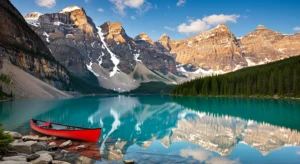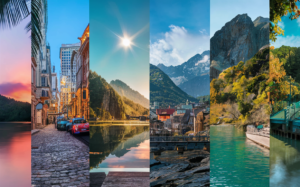Table of Contents
Your First Vietnam Vacation: A Beginner’s Guide to an Unforgettable Adventure
Picture this: the scent of sizzling garlic and fish sauce wafting from a sidewalk stall, the gentle hum of a million motorbikes weaving through city streets, and the breathtaking sight of emerald-green peaks jutting out of a calm sea. This isn’t a scene from a movie; it’s just a regular Tuesday in Vietnam.
If you’re dreaming of a Vietnam vacation, you’re not alone. The country welcomed over 12 million international visitors in the first three quarters of 2023 alone, a number skyrocketing back to pre-pandemic levels. But with so much to see—from the chaotic energy of Hanoi to the tranquil waters of Ha Long Bay and the rice paddies of Sapa—where does a beginner even start?
Don’t worry, that’s where this guide comes in. We’re going to walk through everything you need to know to plan a trip that’s equal parts adventure, relaxation, and culinary delight. Forget the overwhelm. By the end of this, you’ll be ready to book your ticket with confidence.
Getting Started: The Nitty-Gritty You Need to Know
Before we get to the fun stuff, let’s tackle the essentials. A little planning here makes the entire journey smoother.
Visas: Your Key to the Country
For most travelers, you’ll need a visa to enter Vietnam. The good news? The process has gotten much easier.
- E-Visa: Citizens of many countries (including the US, UK, Australia, and Canada) can now apply for an e-visa online through the official Vietnam Immigration Portal. It’s typically processed in 3-5 days, is valid for up to 90 days, and allows for entry at most international airports and land borders. This is usually the best option for tourists.
- Visa on Arrival (VOA): This is popular with travelers flying into major airports like Hanoi or Ho Chi Minh City. You need to arrange an approval letter online through a reputable agency before you travel. You present this letter upon arrival, fill out a form, pay a stamping fee, and get your visa. It sounds more complicated than it is, but e-visas are often simpler.
My advice? Double-check the requirements on the official government site a few months before your trip. Rules can change, and it’s the most trustworthy source.
When to Go: Timing Your Vietnam Trip
Vietnam is a long, skinny country with varied climates. There’s no single “best” time to visit the whole country, but you can always find sunshine somewhere.
- North (Hanoi, Sapa, Ha Long Bay): Has distinct seasons. October to April offers cooler, drier weather—perfect for trekking. Summers (May-Sept) are hot, humid, and rainy.
- Central (Hue, Hoi An, Da Nang): Experiences its rainy season from September to January. The best weather is typically from February to May.
- South (Ho Chi Minh City, Mekong Delta): Warm to hot year-round with a distinct dry season (Nov-Apr) and rainy season (May-Oct), where downpours are heavy but often short.
So, if you’re planning a classic north-to-south trip, the spring (March-April) or autumn (October-November) often provides the most pleasant balance.
Crafting Your Vietnam Itinerary: The Classic Route for First-Timers
Most first-time visitors focus on a north-south journey over about two weeks. Here’s a breakdown of the can’t-miss spots.
Hanoi: The Historic Heart
Hanoi, the capital, is a city of contrasts. Ancient pagodas stand beside French colonial architecture, all swirling in a vortex of motorbikes.
- Get Lost in the Old Quarter: This is the soul of Hanoi. Each of the 36+ streets was historically dedicated to a specific craft—Silk Street, Silver Street, Bamboo Street. It’s a labyrinth best explored on foot. Stop for a cup of ca phe sua da (Vietnamese iced coffee) at a tiny plastic stool cafe and just watch the world go by.
- Watch a Water Puppet Show: This unique 1,000-year-old art form originated in the rice fields of the north. The Thang Long Water Puppet Theatre offers a colorful, musical glimpse into Vietnamese folklore.
- Pay Respects at Ho Chi Minh’s Mausoleum: A site of immense national importance, this is where the preserved body of “Uncle Ho” rests. It’s a solemn and fascinating experience, but remember to dress respectfully (no shorts or sleeveless tops).
Ha Long Bay: A Landscape of Limestone Giants
A few hours east of Hanoi lies one of the New7Wonders of Nature. Ha Long Bay’s thousands of limestone karsts rising from emerald waters are a sight you’ll never forget.
The best way to experience it? An overnight cruise. You’ll kayak through hidden lagoons, explore surreal caves like Sung Sot (Surprise Cave), and wake up to a misty, breathtaking vista. For a less crowded alternative, look into cruises that visit the adjacent Lan Ha Bay, which is just as stunning.
Hoi An: The Enchanting Lantern Town
If there’s one place that captures hearts, it’s Hoi An. This ancient port city is a UNESCO World Heritage site, and it feels like stepping back in time.
- Stroll the Ancient Town by Lantern Light: By day, it’s beautiful. By night, when the silk lanterns glow, it’s pure magic. The town is pedestrian-friendly, so you can wander without the usual traffic worries.
- Get Clothes Tailored: Hoi An is famous for its hundreds of tailor shops. You can have anything from a custom suit to a silk dress made in just 24-48 hours. Do your research, read reviews, and communicate clearly for the best results.
- Take a Cooking Class: The food in Hoi An is exceptional. A cooking class often starts with a thrilling basket boat ride through a water coconut forest and a visit to a vibrant local market before you learn to make classics like Cao Lau (a noodle dish unique to Hoi An).
Ho Chi Minh City: The Pulse of Modern Vietnam
Formerly known as Saigon, this is Vietnam’s bustling economic engine. It’s faster, louder, and more modern than Hanoi, but no less fascinating.
- Learn the History at the War Remnants Museum: This is a difficult but essential visit. The museum presents a sobering perspective on the Vietnam War (known there as the American War). It’s a powerful reminder of the resilience of the Vietnamese people.
- Explore the Cu Chi Tunnels: Just outside the city, this vast network of underground tunnels was used by Viet Cong soldiers. You can even crawl through a (slightly widened) section yourself—a truly unforgettable, claustrophobic history lesson.
- Experience the Cafe Apartment Building: This quirky, nine-story building on Nguyen Hue Walking Street is packed with independent cafes and boutiques. It’s a perfect example of the city’s creative, entrepreneurial spirit.
Eating Your Way Through Vietnam: A Food Lover’s Primer
Let’s be honest, for many, the food is the main event. Vietnamese cuisine is fresh, balanced, and bursting with flavor.
- Pho: The national dish. A fragrant beef or chicken noodle soup is eaten any time of day, but especially for breakfast.
- Banh Mi: A legacy of the French colonial era, this is a perfect baguette stuffed with pate, cold cuts, pickled vegetables, and herbs.
- Bun Cha: Hanoi’s signature lunch. Grilled pork patties and belly served in a sweet-and-sour broth with rice noodles and a mountain of fresh herbs.
- Goi Cuon (Fresh Spring Rolls): Translucent rice paper rolls packed with shrimp, pork, vermicelli, and herbs, served with a peanut dipping sauce.
A quick tip: Don’t be afraid of the street food! The high turnover means it’s often the freshest and most delicious food you’ll find. Look for busy stalls with locals.
Navigating Your Vietnam Holiday Like a Pro
- Getting Around: For long distances, domestic flights are cheap and efficient. Overnight trains (like the one from Hanoi to Sapa or Hue) are a classic experience. For shorter hops, buses and private cars are great. Within cities, ride-hailing apps like Grab are a lifesaver—you get a fixed price and no language barrier issues.
- Money: The local currency is the Vietnamese Dong (VND). Carry cash, especially for markets and small eateries. ATMs are widely available in cities.
- Cultural Sensitivity: Vietnamese people are incredibly warm and forgiving, but a little effort goes a long way. Dress modestly when visiting temples and pagodas. A smile is your most valuable tool.
Frequently Asked Questions (FAQs)
Q: Is Vietnam safe for tourists?
A: Absolutely. Vietnam is generally a very safe country for travelers. Petty crime like bag-snatching can occur in big cities, so be vigilant with your belongings, especially on motorbikes. The biggest danger is often the traffic, so take your time when crossing the street!
Q: How much should I budget for a two-week Vietnam vacation?
A: Vietnam is fantastic for travelers on any budget. A comfortable, mid-range experience—with nice hotels, tours, and eating well—could cost between $1,000 – $2,500 per person, excluding international flights. You can do it for much less by staying in hostels and eating locally, or spend more on luxury resorts and private guides.
Q: What’s the best way to handle the language barrier?
A: While English is not widely spoken outside tourist centers, you’ll be surprised how far a smile, a few key phrases (Xin Chao for hello, Cam On for thank you), and Google Translate can get you. People are very helpful and will appreciate your effort.
Q: Should I book everything in advance?
A: For a first trip, booking your first few nights’ accommodation and any key domestic flights is a good idea, especially during peak season. This gives you peace of mind upon arrival. For things like tours and onward travel, you can often arrange them easily (and sometimes cheaper) once you’re there through your hotel or a local tour agency.
Q: Is it easy to get a SIM card for data?
A: Extremely easy. You can buy a tourist SIM card right at the airport upon arrival. Providers like Viettel, Vinaphone, and Mobifone offer affordable packages with plenty of data for navigating and staying connected.
Your Adventure Awaits
A Vietnam vacation is more than just a trip; it’s an immersion into a culture that’s both ancient and rapidly modernizing. It’s about the thrill of navigating a bustling market, the peace of a sunrise over a misty bay, and the joy of discovering a new favorite dish on a street corner.
The planning might seem daunting now, but trust me, the moment you arrive, it will all click into place. Vietnam has a way of getting under your skin in the best possible way. So do your research, pack your sense of adventure, and get ready for an experience you’ll be talking about for years to come.
Ready to start planning? For the most up-to-date official travel information, always check the Vietnam National Administration of Tourism website.

Vietnam vacation



